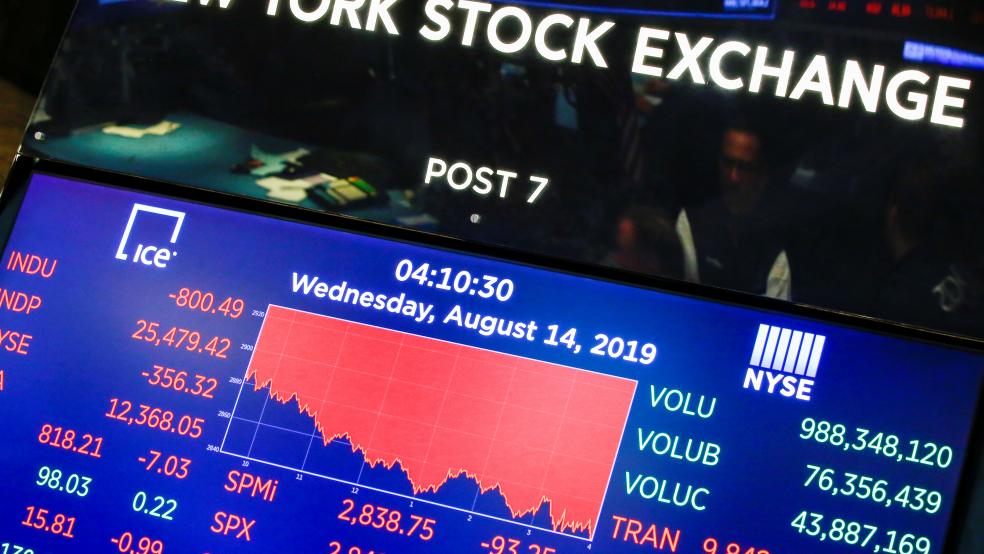Investors scrambled for cover Wednesday as the bond market flashed a signal that a recession may be on the way, sending stocks sharply lower, with the Dow Jones Industrial Average falling 800 points, or 3%, its biggest drop of the year.
Early in the day, U.S. Treasury bonds experienced a yield curve inversion, with the yield on 10-year Treasuries dropping below that on 2-year bonds, reversing the usual pattern. This kind of inversion preceded each recession over the past 50 years and is thus viewed by many as an indicator that another downturn will occur sometime in the next 10 to 24 months.
Not all inversions have been followed by recessions, though, and few analysts are now forecasting an impending U.S. downturn, but most agree that the burgeoning signs of a global economic slowdown — which include negative growth in Germany and Great Britain, currency devaluation in China and the growing toll that President Trump’s trade war is taking on U.S. businesses — suggest that the Federal Reserve will start cutting interest rates more aggressively in a bid to boost domestic growth.
But the Fed, which cut rates in July from 2.25% to 2% in the first reduction in more than a decade, has relatively little room to maneuver given that rates are already low by historical standards. That suggests to some observers that the federal government may have to turn to fiscal policy as part of any effort to fight a potential recession.
Jim Lebenthal of Cerity Partners said on CNBC Wednesday that, in his view, the Fed lacks the ability to sufficiently boost the economy and that the coming slowdown calls for a fiscal response, in the form of infrastructure spending or a tax holiday. “You need fiscal stimulus,” Lebenthal said.
Economist Paul Krugman agreed, saying Wednesday that low interest rates were a sign that the economy needs the kind of help fiscal stimulus could deliver. “These low, low rates are telling us several things,” Krugman tweeted. “(a) private investment demand is really weak despite tax cuts (b) recession risks are pretty high (c) infrastructure! I mean, with borrowing virtually free, why not fix all those falling-down bridges?”
Politically, however, fiscal stimulus seems unlikely. Jared Bernstein, former chief economist to Vice President Joe Biden, said that the “most important thing you need an administration and Congress to do in a downturn is to quickly offset the demand contraction with fiscal stimulus.” But that means doing things that the Trump administration has been unable or unwilling to do, including bolstering the social safety net and investing in infrastructure.
On top of that, the U.S. just went through a period of fiscal stimulus from the tax cuts and the spending boost that began in 2018, which delivered modestly higher growth but also higher debt. “We’ll be entering the next recession with a debt-to-GDP ratio that’s twice the historical average (80 vs. 40 percent),” Bernstein said, with annual deficits projected to top $1 trillion as soon as this year.
So far, there are no signs that the Trump administration is taking any steps to address a potential recession using fiscal policies, and the president on Wednesday again blamed the Federal Reserve for signs of economic turmoil, insisting that the U.S. is “winning, big time, against China” even as others point to his trade war as a key reason many businesses have stopped investing.
“White House officials have not begun talks about how to deal with mounting problems in the global economy,” Damian Paletta of The Washington Post wrote Wednesday. “There are no real discussions of any stimulus, in part because they already cut taxes and boosted spending. Their main tactic is pressure [Fed chair Jay] Powell.”




